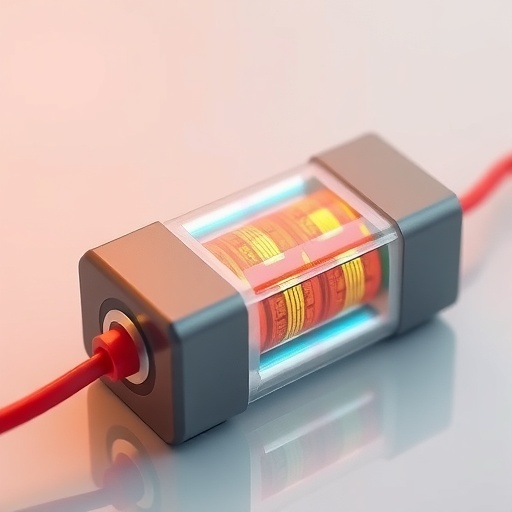Recent advancements in energy storage technologies have prompted extensive research into materials that can enhance the performance of supercapacitors. A recent study conducted by Thenpandiyan, Ramasamy, Suresh, and their team is shedding light on the role of major rare earth ions—specifically Yttrium (Y³⁺), Lanthanum (La³⁺), and Gadolinium (Gd³⁺)—in augmenting the supercapacitor performance of calcium carbonate (CaCO₃) nanocomposites. With rising global energy demands and the need for sustainable solutions, understanding the intricacies of these ion-doped materials could pave the way for more efficient energy storage systems.
The main allure of supercapacitors lies in their potential to provide rapid charge-discharge cycles, longer life spans, and greater energy densities compared to traditional capacitors. However, the continuous demand for improved performance has been a challenge for researchers. This new study explores how doping CaCO₃ nanocomposites with specific rare earth ions can significantly improve their electrochemical characteristics, thus enhancing the overall performance of supercapacitors.
To understand the implications of these findings, it is essential to delve into the electrochemical properties that define supercapacitor performance, such as capacitance, energy density, and rate capability. The researchers employed advanced techniques including cyclic voltammetry and electrochemical impedance spectroscopy to analyze the behavior of the doped nanocomposites. Their results indicate that incorporating Y³⁺, La³⁺, and Gd³⁺ into the CaCO₃ matrix amplifies the electrical conductivity and capacitance of the materials, thus creating a superior energy storage medium.
Through detailed experimentation, the research team demonstrated that the incorporation of Y³⁺ ions contributed significantly to the increase in specific capacitance, surpassing the performance of undoped CaCO₃ nanocomposites. The ionic radius and electronic configuration of rare earth elements enable them to optimize the charge distribution within the nanocomposite structure, promoting enhanced electron transport pathways necessary for effective charge storage.
Additionally, Lanthanum ions were found to play a pivotal role in stabilizing the crystal structure of CaCO₃, further bolstering its capacitance properties. This structural stability is crucial for maintaining supercapacitor performance over extended cycling periods, thus making these materials viable for commercial applications. Furthermore, the unique magnetic properties of Gadolinium ions were shown to further influence the supercapacitor’s characteristics, offering an intriguing avenue for future research into multifunctional materials.
The development of such advanced materials does not come without challenges. Sustainability and environmental concerns related to the extraction of rare earth elements are significant considerations. Researchers are therefore also exploring methods to recycle and make use of existing rare earth materials to mitigate these issues. The advancements noted in this study represent not only a technological leap but also an opportunity for sustainable innovation in energy storage solutions.
Moreover, as the demand for portable electronic devices and electric vehicles increases, the quest for efficient energy storage systems becomes ever more critical. The implications of these findings extend far beyond academic circles; they hold the promise of transforming how energy is stored and utilized in real-world applications. A comprehensive understanding of how these rare earth ions interact within nanocomposites could open up pathways for even more revolutionary energy technologies.
The multi-faceted approach taken by the research team, examining both the chemical and structural properties of their materials, exemplifies the intertwining nature of material science and energy technology. The synthesis of Y³⁺, La³⁺, and Gd³⁺ doped CaCO₃ nanocomposites illustrates a potent collaborative merging of chemistry and engineering aimed at tackling pressing energy issues.
The future of supercapacitor technologies appears to be on the cusp of a significant breakthrough, driven by innovative research such as this. As researchers continue to refine the synthesis and testing processes, the scalability of these materials will be a prime focus. Enabling widespread industrial applications will be critical for translating laboratory successes into market-ready products.
In conclusion, the remarkable findings of Thenpandiyan and colleagues underscore the immense potential held within rare earth-doped materials in enhancing supercapacitor performance. As researchers seek novel ways to integrate these insights into practical solutions, the energy landscape may potentially witness a transformation that prioritizes efficiency, sustainability, and longevity in energy storage solutions.
With the drive for technological advancement meeting the urgency of environmental awareness, this research highlights how the intersection of materials science and sustainable practices can give rise to innovative solutions. The results of these investigations are likely to reverberate through the fields of energy storage, providing inspiration for future research endeavors that seek to harness the full potential of novel materials for a greener tomorrow.
Subject of Research: The role of rare earth ions in enhancing supercapacitor performance.
Article Title: Role of major rare earth (Y3+, La3+, and Gd3+) ions on enhancing supercapacitor performance of CaCO3 nanocomposites.
Article References:
Thenpandiyan, E., Ramasamy, V., Suresh, G. et al. Role of major rare earth (Y3+, La3+, and Gd3+) ions on enhancing supercapacitor performance of CaCO3 nanocomposites. Ionics (2025). https://doi.org/10.1007/s11581-025-06667-6
Image Credits: AI Generated
DOI: https://doi.org/10.1007/s11581-025-06667-6
Keywords: Supercapacitors, rare earth ions, calcium carbonate, Yttrium, Lanthanum, Gadolinium, energy storage, nanocomposites, sustainability, electrochemical properties.
Tags: advanced energy storage solutionscalcium carbonate nanocompositescapacitance and energy densitydoping materials in supercapacitorselectrochemical characteristics of supercapacitorselectrochemical impedance spectroscopy techniquesenergy storage technologiesenhancing supercapacitor performancerapid charge-discharge cyclesrare earth ions in supercapacitorssustainable energy storage systemsYttrium Lanthanum Gadolinium ions





